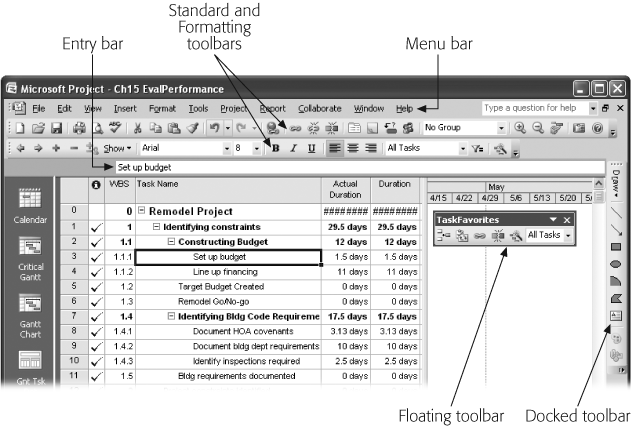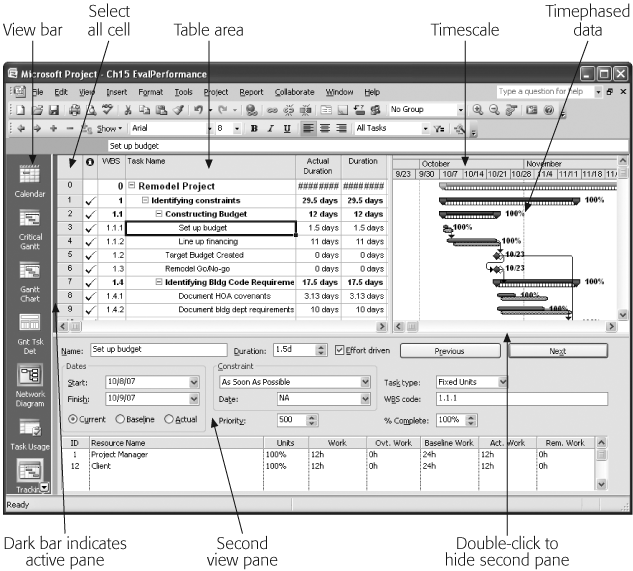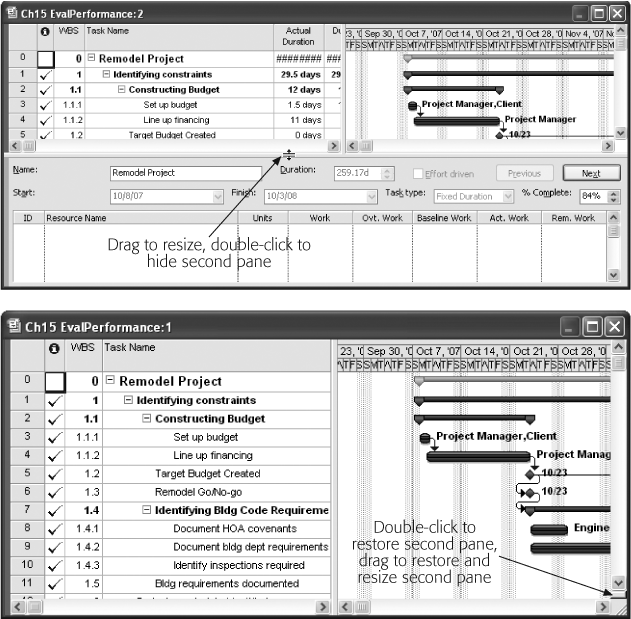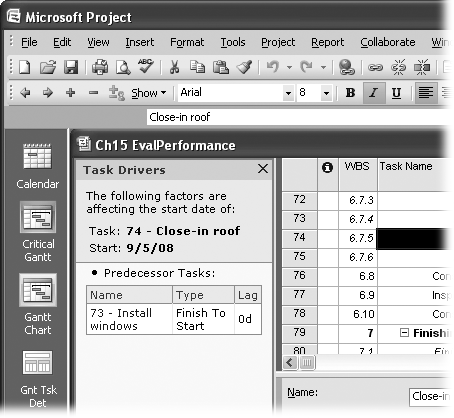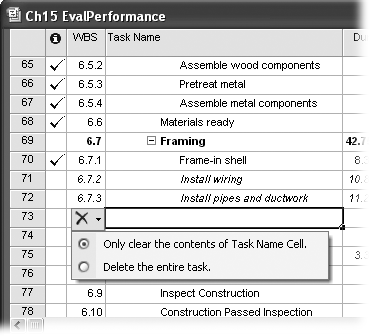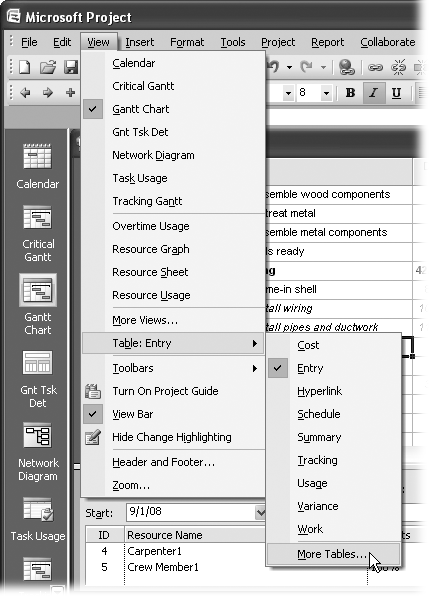People have been managing projects for centuries. The construction of the mountain-top city of Machu Picchu was a project—although no one’s really sure whether the ancient Inca had a word for “project manager.” In fact, you may not have realized you were a project manager when you were assigned your first project to manage. Sure, you’re organized and you can make sure people get things done, but manag-ing a project successfully requires specific skills and know-how. Whether you’re building a shining city on a hill or aiming for something more mundane, Microsoft Project helps you document project tasks, build a schedule, assign resources, track progress, and make changes until your project is complete.
Perhaps you’re staring at the screen, wondering about the meaning of the Gantt Chart and Network Diagram in the list of Project views. Or maybe you already have dozens of Project schedules under your belt. Either way, Project features can be mystifying. You know what you want to do, but can’t find the magic combination that makes Project do it.
This book addresses the double whammy of learning your way around project management and Microsoft Project at the same time. It provides an introduction to managing projects, and shows you how to use Project to do so. For more experienced project managers, this book can help you take your Project prowess to a new level with tips, timesaving tricks, and mastery of features that never quite behaved the way you wanted.
Since its introduction, Project Server has gotten most of Microsoft’s attention and cool new features. But not this time. Project 2007 Standard and Professional have several handy new features worth looking at. For example, change-oriented features like task drivers, change highlighting, and multilevel undo help you deal with schedules that change ever more rapidly. Here’s an overview of the new Project 2007 features and where to find them in this book:
Why tasks start when they do. If you’re trying to shorten a schedule, task drivers (See Why Tasks Start When They Do) show the factors that influence when a task starts—so you know what changes could lead to an earlier start date. The controlling factor may be a predecessor, calendar, date constraint, or all of the above; the Project 2007 Task Drivers pane lists all the ones that affect the selected task. Then, it’s up to you to decide which one to change and how.
What just changed? When you make a change in a Project schedule, the problems you’re trying to fix may not go away, or new problems you didn’t anticipate may crop up instead. Until now, people had a hard time detecting a cascade of changed values in a table full of numbers. Change highlighting (Seeing What Changes Do) shades cells whose values changed due to the last edit you made, making the cells with new values easy to see. Moreover, you can switch to other tables and see the changes highlighted there, too (to see whether the earlier dates you achieved increased costs, for instance).
Highlight key information. The wizard behind change highlighting’s magic is merely a special application of background cell highlighting (Changing Selected Text). Project has always been able to change the font, color, and size of different categories of text like critical tasks or milestones. In Project 2007, you can now change the background color of the cells for those categories, too. For example, if you used to use red text for critical tasks, you know that colored text can be hard to read. Now, you can change the background color of table cells for critical tasks to red, and keep the text a legible black.
Identify nonworking time. In Project 2007, calendars (Defining Work Schedules with Calendars) work a little differently. Once you get used to them, you’ll find that defining when resources work or don’t work is much easier than before. You can define a standard work week and then go on to define alternative work weeks, for example, for the half-days on Friday throughout the summer. Moreover, exceptions to the work week are perfect for flagging project-wide holidays, resources’ vacations, and other nonworking time.
Backtracking and playing what-if games. Project managers who used earlier versions of Project know how frustrating the previous one-step undo was. Typically, it takes several steps to see if a strategy is going to work. In Project 2007, you can now undo as many changes as you want (Playing What-if Games), whether to try out an idea or to recover from a mistake you didn’t see until six changes later.
Analyze and communicate project information. Visual reports (Working with Visual Reports) are based on Excel pivot charts and Visio pivot diagrams, so you can slice and dice data in different ways if you have Excel or Visio on your computer. They’re ideal for getting to the bottom of a problem or answering questions that arise in a status meeting. For example, a visual report may show cost by project phase at first, but you can twist it to show cost by quarter or drill down to show cost by lower-level tasks or specific resources.
Make progress or problems stand out. Rows upon rows of data are a headache waiting to happen, especially when you’re trying to see what’s going right or wrong. Graphical indicators like green, yellow, and red stoplights for progress have been available in custom fields for a few versions. In Project 2007, visual reports can also show graphical indicators, so you can communicate high-level status even more easily.
Tracking all kinds of costs. In earlier versions, Project calculated labor and material costs, but other types of costs like travel, fees, printing, and so on, were harder to handle. The Fixed Cost field was the one place to lump these sorts of costs. In Project 2007, the new cost resource (Creating a project organization chart in Microsoft Visio) makes it easier to assign and track different types of costs that aren’t labor- or material-oriented. For example, you can create cost resources for airfare, lodging, and printing. Then, you can assign several cost resources to a task or the same cost resource to several tasks. In the Resource Usage view, the total cost for a cost resource tells you how much you’re spending on that type of cost.
Comparing budget numbers to Project numbers. Most budgets have to tow the financial line handed down by the project customer or stakeholders. If the budget you get is divvied up among different financial accounts, you can use the new budget resources (Comparing Costs to Your Budget) to compare your project spending against accounting budget line items. Budget resources link to the project summary task; you set the budgeted cost or budgeted work for the entire project or allocate the budgeted costs at the project level over time. Then, you assign your Project resources to different budget categories so you can see how your project costs compare to the budget.
Any project manager who’s calculated task start and finish dates by hand knows how helpful Project is. Simply calculating dates, costs, and total assigned work eliminates a mountain of grunt work, so you have time left over to actually manage your projects.
In the planning stage, Project helps you develop a project schedule. You add the tasks and people to a Project file, link the tasks together in sequence, assign workers and other resources to those tasks, and poof!—you have a schedule. Project calcu-lates when tasks start and finish, how much they cost, and how many hours each person works each day. Project helps you develop better project plans, because you can revise the schedule quickly to try other strategies until the plan really works. Views and reports help you spot problems like too many tasks assigned to the same overworked person.
Once a project is underway, you can add actual hours and costs to the Project file. With actual values, you can use Project to track progress to see how dates, cost, and work compare to the project plan. If problems arise, like tasks running late or overbudget, you can use Project views and reports to look for solutions, once again quickly making changes until you get the project back on track.
At the same time, plenty of project management work goes on outside of Project. Touchy-feely tasks like identifying project objectives, negotiating with vendors, or building stakeholder buy-in are pure people skill (although Project’s reports can certainly help you communicate with these folks). Projects produce a lot of documents besides the project schedule. For example, a project plan may include financial analysis spreadsheets, requirements and specifications documents, change requests databases, and diagrams to show how the change management process works. In addition, thousands of email messages, memos, and other correspondence could change hands before a project finishes.
Communication, change management, and risk management are essential to successful project management, but they don’t occur in Project. For example, you may have a risk management plan that identifies the risks your project faces, and what you plan to do if they occur. You may also develop a spreadsheet to track those risks and your response if they become reality. In Project, you may link the risk tracking spreadsheet or risk response document to the corresponding tasks, but that’s about it.
In one respect, choosing between Project Standard and Project Professional is easy. Both editions of Project have the same capabilities if you manage projects independently, and aren’t trying to work closely with other project managers, teams, and projects. Project Standard is all you need for a one-person show, even if you manage several projects at the same time. You can communicate with your team via email and share documents on a network drive, or using a SharePoint Web site (Preserving the Original Plan in Project).
However, if you manage project teams with hundreds of resources, share a pool of resources with other project managers, or manage your project as one of many in your organization’s project portfolio, then you’ll need Project Professional along with Project Server and Project Web Access. The difference between Project Standard and Project Professional is that you can turn on the enterprise features in Project Professional and connect it to Project Server and Project Web Access to collaborate, communicate, and share across hundreds of projects and people.
Setting up an enterprise-wide project management system takes some planning and effort, depending on the size and complexity of your organization. Whether your company is small, medium, or large, you must weigh the benefits of managing projects company-wide against the effort and expense of defining project management policies, setting up the system, and bringing everyone up to speed. Here are some of the advantages that Project Professional and the enterprise project management software offer:
Track all projects in one place. You build Project schedules with Project Profes-sional. When a project is ready for prime-time, you publish it to Project Server to add it to the overall project portfolio. Then, the status for all projects appears in a single view.
Share resources enterprise-wide. Instead of playing phone tag with other project managers about when resources are available, Project Server keeps track of all resources and when they work on which project. You can look for the right kind of resources using multilevel resource skill characteristics, and then see who’s available for your projects.
Communicate with resources. Project Web Access makes it easy for you to communicate with your team, requesting status, sending messages, and so on. It also makes it easy for your team to communicate with you, replying with status, accepting assignments, or providing time worked.
Timesheets. Team members can fill out timesheets for project work. The time they submit shoots straight into the Project Server database to update progress on your projects.
Track issues, risks, and documents. Projects are more than schedules. Issues crop up that must be resolved; risks lurk that you must watch and manage; and there’s no end to the additional documents produced like specifications, plans, work packages, and so on. Using SharePoint Web sites and Project Web Access, team members can collaborate on all these elements online.
Managing a project requires other programs in addition to Project. Word and Excel are eager participants for the documents and financial analysis you produce. PowerPoint is ideal for project presentations and status meetings. And, Outlook keeps project communication flowing. This book includes instructions for using these programs in some of your project management duties.
Office 2007 Standard includes Word, Excel, PowerPoint, and Outlook. The list price is $399.95, although lower prices are readily available. You can purchase Office at stores like Staples or Web sites like www.bestbuy.com. Office 2007 Profes-sional adds Publisher, Business Contact Manager, and Access to the Office Standard suite for a total list price of $499.95. Here are some of the ways you might use these products in project management:
Word. Producing documents like the overall project plan, work package descriptions, requirements, specifications, status reports, and so on.
Excel. Spreadsheets for financial analysis or tracking change requests, risks, issues, and defects reported.
PowerPoint. Presentations for project proposals, project kickoff, status, change control board meetings, and so on.
Outlook. Emailing everyone who’s anyone on the project team and setting up a shared address book for everyone to use.
Publisher. Project newsletters, flyers, invitations to meetings, and so on.
Access. A more robust alternative to Excel for tracking change requests, requirements, risks, and issues.
Visio 2007 Professional is another program that comes in handy, whether you want to document project processes in flowcharts or generate Visio-based visual reports. Visio Professional’s list price (which is required for PivotDiagrams and Data Graphics) is $559.95.
The Project window is chockablock with panes and other parts that either show the information you want or help you work faster. Some features, like the menu bar and the main Project view, are always available, while others (like the View Bar, Project Guide, and toolbars) can hide until you need them. This section gives you a tour of the Project interface, including a few of the more subtle timesavers tucked away here and there.
Note
Project’s menus haven’t switched to the new Office ribbon that Word, Excel, and PowerPoint 2007 use. Although the ribbon may be in Project’s future, for now, you can find your favorite Project com-mands in the same places as before.
The menu bar, the Standard toolbar, and the Formatting toolbar sit at the top of the Project window just the way they have in the past, as shown in Figure I-1. You can display the two toolbars on one line or two, or move them to other parts of the screen if you prefer (Customizing Menus and Toolbars). In most cases, docking these basic toolbars near the menu bar keeps the way clear for views and task panes you work in every day. (Besides, you may have other toolbars like Resource Management, Tracking, or a custom toolbar floating in other areas of the window.) The entry bar is the other horizontal strip near the top of the window, although in most cases, you’ll find that you type or edit directly in forms or table cells.
Managing projects means looking at project information in many different ways, which explains all the built-in views that Project provides out of the box. Even so, you’ll find that you create quite a few views of your own. As you’ll learn in Chapter 23, views come in single-pane and combination variations. The combination view has a top pane and bottom pane like the one shown in Figure I-2, which has the Tracking Gantt view (a single-pane view) on top and the Detailed Task Form (another single-pane view) on the bottom. The box on Views explains how to apply views and switch between one and two panes.
In addition to the top and bottom view panes, some views have two pane-like parts of their own that appear side by side. For views like the Gantt Chart and Task Usage views, the left side of the view is a table with columns of Project fields and rows for tasks, resources, or assignments. You can add or edit values directly in the table or use it simply for reviewing. The timescale and timephased data on the right side shows data apportioned over time. In a Gantt Chart view, taskbars show when tasks begin and end. The Task Usage view uses a timephased table instead, in which the columns represent time periods, and rows are tasks and assignments.
The All Cells box sits innocently to the left of the table’s column headings (immediately above the first ID cell). Right-click it, and a shortcut menu appears so you can switch to another table. The shortcut menu also has the More Tables command, which opens the More Tables dialog box to choose any table. If you click the All Cells box instead, Project selects all the cells in the table (thus the cell’s name). Then, you can copy the entire table, export it, format it, and so on.
Figure I-2. You can choose View. More Views to select any view that’s available, but the View bar is a great shortcut for your favorite views. To add a favorite view to the View bar, edit the view (Modifying a single-pane view), and then turn on the “Show in menu” checkbox.
Tip
The actions you can perform depend on which view pane is active. If you select a new view, then Project replaces the active pane. Project identifies the active pane by darkening the narrow vertical bar to the left of the pane, and lightening the vertical bar in the other pane.
Figure I-3. Top: To adjust the heights of the two panes, position the pointer over the horizontal divider. When the pointer changes to a two-headed arrow, drag up or down to resize both panes. Bottom: To restore the second pane and set its height at the same time, drag the box below the vertical scrollbar until the second pane is the height you want.
Just to keep life interesting, Project also has task panes (no relation to view panes) for different Project-related activities. For example, when you choose File →New, the New Project task pane opens on the left side of the Project window, with several options for creating a new Project file. Choose Project →Task Drivers, and the Task Drivers pane appears to the left of your views, as shown in Figure I-4.
ScreenTips and SmartTags are two other Project features that make temporary appearances. Project’s ScreenTips blossom into view when you position the pointer over an item with a ScreenTip, like the icons in the Indicators column in a table. A date constraint icon tells you the type of constraint and the date. A Task Note icon displays a ScreenTip with part of the task note. To learn about the purpose of a Project field or how it’s calculated, position the cursor over a column header in a view and read the screenshot that appears.
Figure I-4. The Task Drivers pane is a newfeature in Project 2007 that shows the factors that control the start date of the selected task. Click its Close button to close it.
SmartTags, on the other hand, appear when you perform certain Project actions that are renowned for confusing beginners. For example, if you select the Task Name cell in a table, and then press Delete, then Project asks if you want to delete just the task name or the entire task, as illustrated in Figure I-5.
Over the years and versions, Project has collected improvements the way sailboat keels attract barnacles. Yet one feature has gotten worse: Project documentation. To use Project successfully, you need to understand something about project management, but that’s an exercise Microsoft leaves to its customers. In a few earlier versions, the program’s help was at least organized around the activities that project managers perform. Now, help is back to describing what Project does rather than what you’re trying to do.
Project Help is optimistically named, because it typically lacks troubleshooting tips or meaningful examples. In some cases, the topic you want simply isn’t there. Project Help rarely tells you what you really need to know, like when and why to use a certain feature. And highlighting key points, jotting notes in the margins, or reading about Project after your laptop’s battery is dead are all out of the question.
The purpose of this book, then, is to serve as the manual that should have accompanied Project 2007. It focuses on managing projects with Project Standard or Project Professional with the aid of a few other Microsoft programs like Word and Excel. The book points out some of the power tools that come with Microsoft’s enterprise project management software, but it doesn’t explain how to set up or use Project Server and Project Web Access. (To learn how to work with Project Server, check out the following books: Microsoft Office Project 2007 Inside Out by Teresa Stover (Microsoft Press) and Ultimate Learning Guide to Microsoft Office Project 2007 by Dale Howard and Gary Chefetz (EPM Learning).
Tip
Although each version of Project adds new features and enhancements, you can still use this book if you’re managing projects with earlier versions of Project. Of course, the older your version of the pro-gram, the more discrepancies you’ll run across.
In this book’s pages, you’ll find step-by-step instructions for using Project Standard and Professional features (minus the ones that require Project Server), including those you might not have quite understood, let alone mastered: choosing the right type of task dependency, the right way to use date constraints, leveling resources, producing reports, and so on. This book helps you be productive by explaining which features are useful and when to use them.
From time to time, this book also includes instructions for using other programs like Word and Excel in your project management duties. Because several of these programs have a radical new look in Office 2007, you’ll find instructions for both the 2007 and 2003 versions of Word, Excel, and so on.
Although this book is primarily a guide to Project 2007, it comes with a healthy dose of project management guidance. The chapters walk you through managing a project from start to finish: getting a project off the ground (initiating), planning, doing the project work (executing), keeping the project on track (controlling), and tying up loose ends (closing). You’ll find practical advice about what project managers do, and how those activities help make projects a success.
Microsoft Project 2007: The Missing Manual is designed to accommodate readers at every level of technical and project management expertise. The primary discussions are written for advanced-beginner or intermediate Project users. First-time Project users can look for special boxes with the title “Up To Speed” to get introductory information that helps absorb the topic at hand. On the other hand, advanced users should watch for similar shaded boxes called “Power Users’ Clinic.” These boxes offer more technical tips, tricks, and shortcuts for the experienced Project fan. Boxes called “Tools of the Trade” provide more background on project management tools and techniques (Gantt Charts, for example). And, if you’ve ever wondered how to extract yourself from a gnarly project management situation, look for boxes called “Reality Check” for techniques you can try when project management textbooks fail you.
Microsoft Project 2007: The Missing Manual is divided into six parts, each contain-ing several chapters:
Part One: Project Management: The Missing Manual is like a mini-manual on project management. It explains what projects are, and why managing them is such a good idea. These chapters explain how to pick the right projects to perform, obtain support for them, and start them off on the right foot. You also get a whirlwind tour of planning a project, which Part Two tackles in detail.
Part Two: Project Planning: More Than Creating a Schedule starts with a quick test drive of Project 2007 to whet your appetite. These chapters then take you through each aspect of planning a project, including breaking work down into manageable pieces, estimating work and duration, building a schedule, assembling a team, assigning resources to tasks, and setting up a budget. The remaining chapters explain how to refine your plan until everyone’s (mostly) happy with it, and then, how to prepare it for the execution phase of the project.
Part Three: Projects in Action takes you from an approved project plan to the end of a project. These chapters explain how to track progress once work gets underway, evaluate that progress, correct course, and manage changes. Other chapters explain how to use Project’s reports and complete important steps at the end of a project.
Part Four: Project Power Tools helps you get the most out of Project. These chapters talk about how to work on more than one project at a time, and share data with programs and colleagues.
Part Five: Customizing Project explains how to customize every aspect of Project to fit your needs—even the toolbars and menus. After all, every organization is unique and so is every project. Other chapters show you how to save time by reusing Project elements (in templates), and boost productivity by recording macros.
Part Six: Appendixes. At the end of the book, three appendixes provide a guide to installing and upgrading Project, a reference to help resources for Project, and a quick review of the most helpful keyboard shortcuts.
To use this book—and Project—you need to know a few basics. Like other Microsoft programs, Project responds to several types of clicking mouse buttons, choosing commands from menus, and pressing combinations of keys for keyboard shortcuts. Here’s a quick overview of a few terms and concepts this book uses:
Clicking. This book gives you three kinds of instructions that require you to use your computer’s mouse or track pad. To click means to point the arrow pointer at something on the screen, and then—without moving the pointer at all— press and release the left button on the mouse (or laptop trackpad). To rightclick means the same thing, but using the right mouse button. To double-click, of course, means to click twice in rapid succession, again without moving the pointer at all. And to drag means to move the pointer while holding down the button the entire time.
When you’re told to Shift+click something, you click while pressing the Shift key. Related procedures, such as Ctrl+clicking, work the same way—just click while pressing the corresponding key.
Menus. The menus are the words at the top of your screen: File, Edit, and so on. Click one to make a list of commands appear, as though they’re written on a window shade you’ve just pulled down. Some people click to open a menu, and then release the mouse button; after reading the menu command choices, they click the command they want. Other people like to press the mouse button continuously as they click the menu title and drag down the list to the desired command; only then do they release the mouse button. Either method works, so choose the one you prefer.
Keyboard shortcuts. Nothing is faster than keeping your fingers on your keyboard, entering data, choosing names, triggering commands—without losing time by grabbing the mouse, carefully positioning it, and then choosing a command or list entry. That’s why many experienced Project fans prefer to trigger commands by pressing combinations of keys on the keyboard. For example, in most word processors, you can press Ctrl+B to produce a boldface word. When you read an instruction like “Press Ctrl+C to copy the selection to the Clipboard,” start by pressing the Ctrl key; while it’s down, type the letter C, and then release both keys.
Throughout this book, and throughout the Missing Manual series, you’ll find sentences like this one: Choose View → Table → More Tables. That’s shorthand for a much longer instruction that directs you to navigate three nested menus in sequence, like this: “Choose View. On the View menu, point to the Table menu entry. On the submenu that appears, choose More Tables.” Figure I-6 shows the menus this sequence opens.
Programs like Word 2007, Excel 2007, and PowerPoint 2007 use a ribbon instead of a menu bar. The arrow shorthand applies to the ribbon as well. For example, Home → Clipboard → Paste → Paste Link is shorthand for selecting the Home tab on the Office ribbon, navigating to the Clipboard section, clicking Paste, and then clicking Paste Link.
Figure I-6. Instead of filling pages with long and hard-to-follow instructions for navigating through nested menus and nested folders, the arrow notations are concise, but just as informative. For example, “Choose View → Table:Entry → More Tables” takes you to the menu shown here.
Similarly, this arrow shorthand also simplifies the instructions for opening nested folders, such as Program Files → Microsoft Office → Office12 → 1033.
At www.missingmanuals.com, you’ll find news, articles, and updates to the books in this series.
But the Web site also offers corrections and updates to this book (to see them, click the book’s title, and then click Errata). In fact, you’re invited and encouraged to submit such corrections and updates yourself. In an effort to keep the book as up-to-date and accurate as possible, each time we print more copies of this book, we’ll make any confirmed corrections you’ve suggested. We’ll also note such changes on the Web site, so that you can mark important corrections into your own copy of the book, if you like.
In the meantime, we’d love to hear your suggestions for new books in the Missing Manual line. There’s a place for that on the Web site, too, as well as a place to sign up for free email notification of new titles in the series.
When you see a Safari® Enabled icon on the cover of your favorite technology book, that means the book is available online through the O’Reilly Network Safari Bookshelf.
Safari offers a solution that’s better than eBooks. It’s a virtual library that lets you easily search thousands of top tech books, cut and paste code samples, download chapters, and find quick answers when you need the most accurate, current information. Try it for free at http://safari.oreilly.com
Get Microsoft Project 2007: The Missing Manual now with the O’Reilly learning platform.
O’Reilly members experience books, live events, courses curated by job role, and more from O’Reilly and nearly 200 top publishers.
